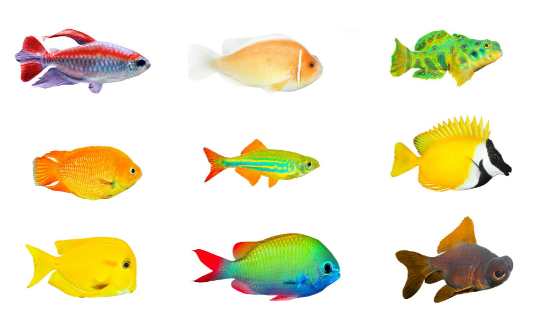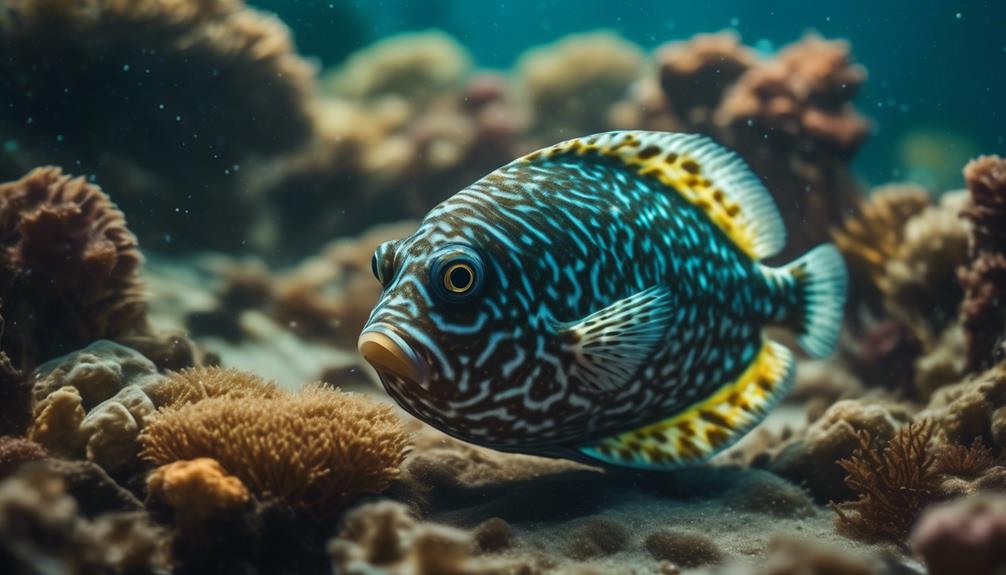
Are you ready to plunge into the captivating world of flounder fish and uncover the intriguing secrets that lie beneath the ocean's surface?
Picture a fish gracefully gliding through the water, resembling a hidden treasure waiting to be discovered.
In this article, we will take you on an enthralling journey to explore the wonders of flounders, their unique characteristics, and the challenges that come with owning these mesmerizing creatures.
Get ready to dive deep and unlock the mysteries of the fascinating world of flounder fish.
Key Takeaways
- Flounders are saltwater fish that require very large aquariums with sand or fine gravel substrate.
- They have a unique body shape and camouflage themselves in their surroundings.
- Flounders are semi-aggressive and should be kept with non-aggressive upper region fish.
- They are carnivorous and feed on small fish and crustaceans, requiring a varied diet in captivity.
Flounder Fish Overview
Flounder fish, with their unique body structure and impressive camouflage abilities, are an intriguing addition to any saltwater aquarium. These fish have a laterally compressed body that lays on its side, giving them a distinct appearance. They also have two bubble eyes on one side of their head, which allows them to see their surroundings while lying flat on the ocean floor.
Flounders are known for their incredible camouflage skills, blending seamlessly into the sandy substrate. They come in various shades of brown, cream, gray, black, or white, helping them disappear into their surroundings.
As semi-aggressive fish, flounders require large aquariums, at least 125 gallons in capacity. They should be kept with non-aggressive upper region fish that aren't small enough to be viewed as prey. Providing them with a sandy substrate and sparsely decorated tank with live rock or hardy corals will help recreate their natural habitat.
Flounders are carnivorous and primarily feed on small fish and crustaceans. In a home aquarium, they should be offered a variety of fresh and frozen meaty foods such as worms, shrimp, and small fish.
To ensure their well-being, it's important to maintain the water conditions of the tank, including a slightly alkaline pH range between 8.1 and 8.4 and moderate hardness between 8 and 12 dKH.
Characteristics of Flounder Fish
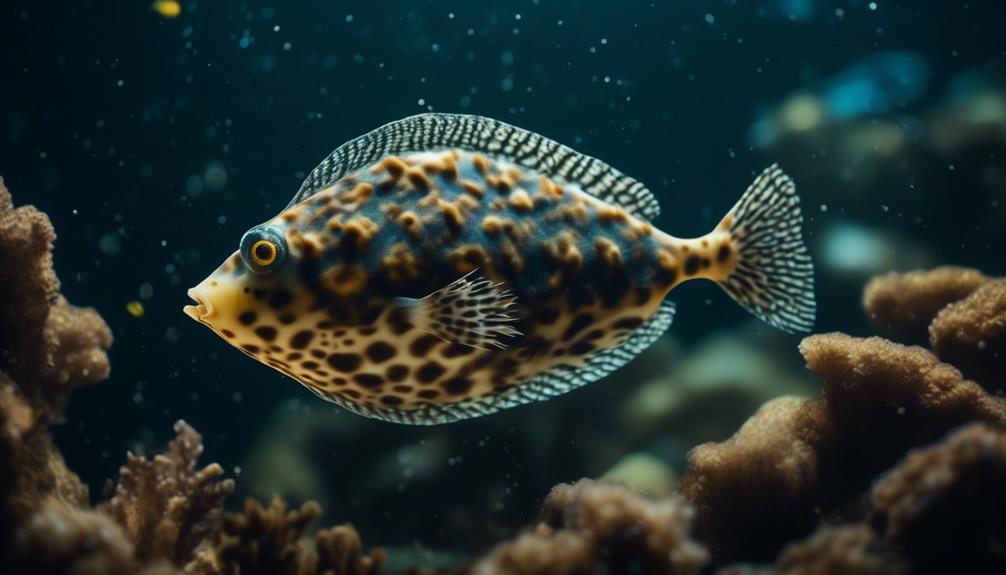
As we delve into the characteristics of flounder fish, it's important to understand their unique physical attributes and behaviors that contribute to their fascinating nature.
Flounders have a laterally compressed body that lays on its side, with two bubble eyes on one side of the head. They feed by camouflaging themselves and lying in wait for prey. These semi-aggressive fish are found in oceans all around the world, particularly in the Western Atlantic and Northwestern Pacific.
Flounders aren't colorful fish, but rather designed to blend into their surroundings in the sandy substrate with combinations of brown, cream, gray, black, or white. In terms of tank requirements, flounders need very large aquariums of at least 125 gallons in capacity, with a bottom swimming region and a sparsely decorated environment. They require slightly alkaline water conditions with a pH range between 8.1 and 8.4 and moderate hardness between 8 and 12 dKH.
As carnivorous fish, flounders primarily feed on small fish and crustaceans, and in the wild, they reproduce by releasing eggs into the water column.
With these characteristics in mind, you can better appreciate the wonder of flounder fish.
Habitat and Distribution of Flounder Fish
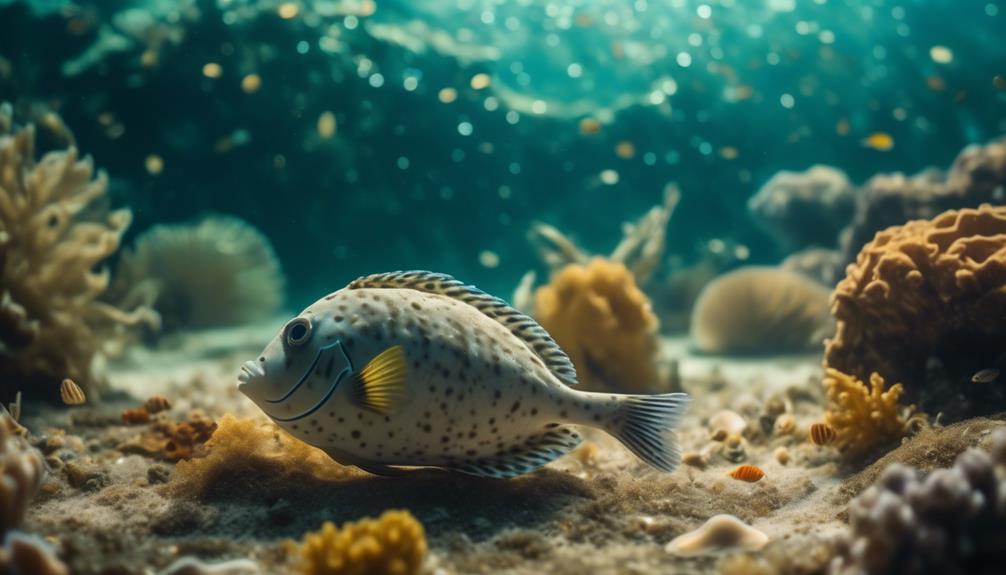
Flounder fish inhabit various oceanic regions around the world and can be found in both the Western Atlantic and Northwestern Pacific. They aren't limited to a specific habitat but are commonly found in sandy or muddy bottoms near shorelines, estuaries, and bays.
These fish are well-adapted to their environment, with their flattened bodies and ability to camouflage into their surroundings. Flounders prefer to live in areas with a moderate to strong current, as it helps them remain hidden and catch their prey.
They're also known to migrate during different seasons, moving from deeper waters to shallower areas for breeding and feeding purposes. Overall, the habitat and distribution of flounder fish vary depending on the species and their specific environmental requirements.
Tank Requirements for Flounder Fish
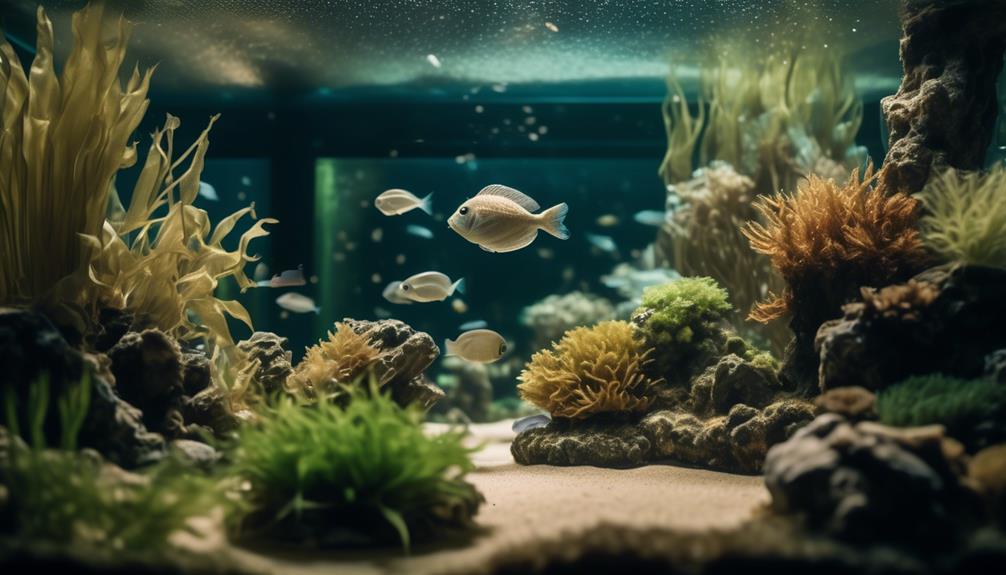
After discussing the habitat and distribution of flounder fish, let's now explore the tank requirements necessary to provide a suitable environment for these fascinating creatures. Here are the tank requirements for flounder fish:
- Suitable tank mates: Non-aggressive upper region fish that aren't small enough to be viewed as prey.
- Swimming region: Bottom. Flounder fish inhabit the lower level of the tank and burrow into the sandy substrate.
- Tank size: Flounder fish require very large tanks, at least 125 gallons in capacity. The aquarium should have a sand or fine gravel substrate and be sparsely decorated with live rock or hardy corals.
These tank requirements are essential for creating a comfortable and safe environment for your flounder fish. By providing the right conditions, you can ensure that your flounder fish thrive in their new home.
Suitable Tank Mates for Flounder Fish
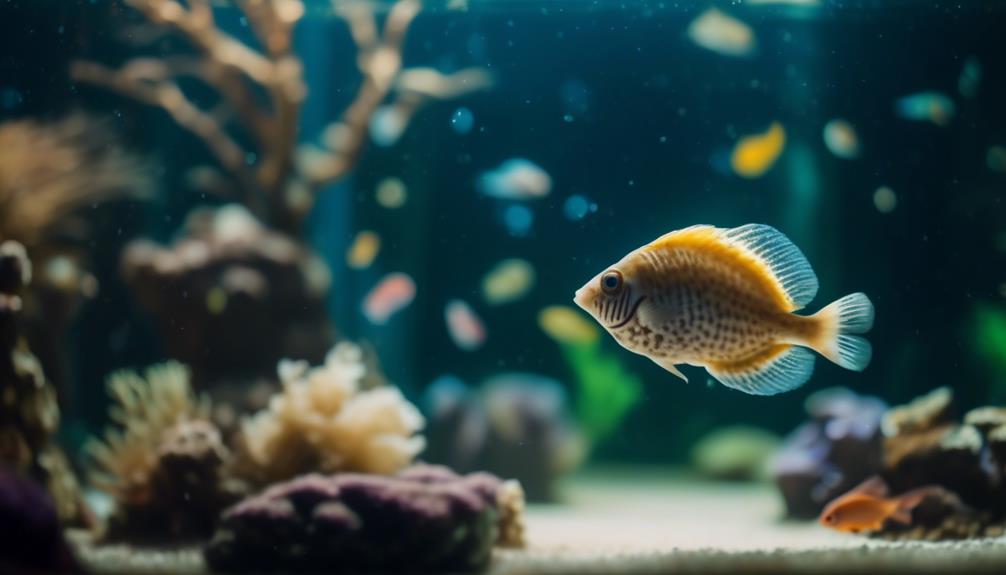
To ensure a harmonious and peaceful tank environment, it's important to carefully select suitable tank mates for your flounder fish. Since flounders are semi-aggressive, it's best to choose non-aggressive upper region fish that aren't small enough to be viewed as prey.
Good tank mates for flounder fish include species like tangs, angelfish, and wrasses. These fish are known for their peaceful temperament and can coexist with flounders without causing any conflicts.
It's essential to provide a very large tank, at least 125 gallons in capacity, to accommodate the needs of both the flounder and its tank mates.
With the right selection of tank mates, your flounder fish will thrive in its aquarium environment.
Feeding Habits of Flounder Fish
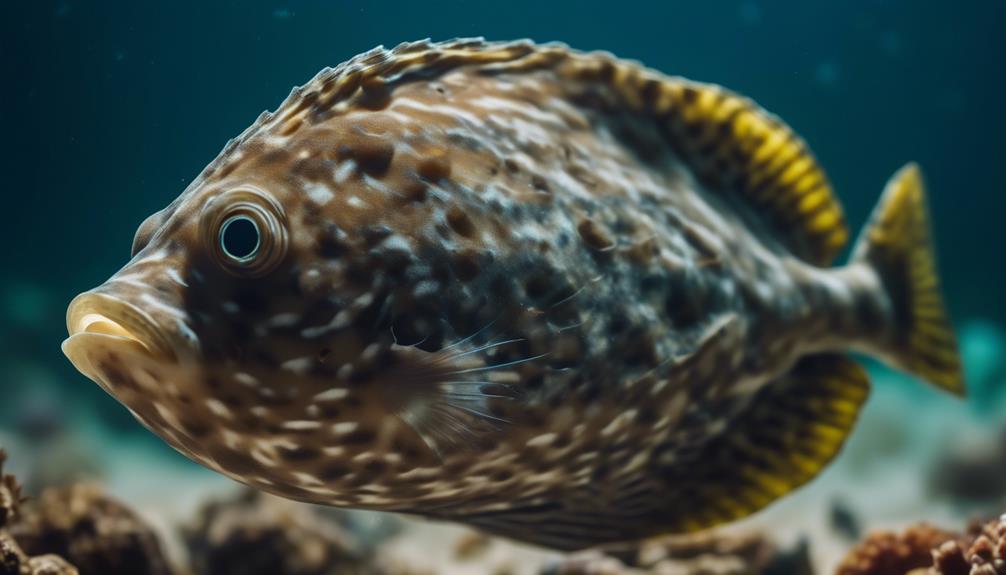
When caring for flounder fish, it's important to understand their feeding habits. These fascinating creatures have unique ways of obtaining their food. Here are three key points to know about the feeding habits of flounder fish:
- Camouflage: Flounder fish feed by camouflaging themselves and lying in wait for prey. Their flat bodies and ability to change color allow them to blend seamlessly into their surroundings, making it easier for them to surprise their unsuspecting prey.
- Carnivorous Diet: Flounder fish are carnivores and primarily feed on small fish and crustaceans in the wild. To ensure their nutritional needs are met in the home aquarium, it's essential to offer them a variety of fresh and frozen meaty foods such as worms, shrimp, and small fish.
- Opportunistic Feeders: Flounder fish are opportunistic feeders, meaning they'll feed whenever the opportunity presents itself. They've a voracious appetite and will consume whatever prey is available to them.
Understanding these feeding habits will help you properly care for and provide the necessary nutrition for your flounder fish.
Breeding Behavior of Flounder Fish
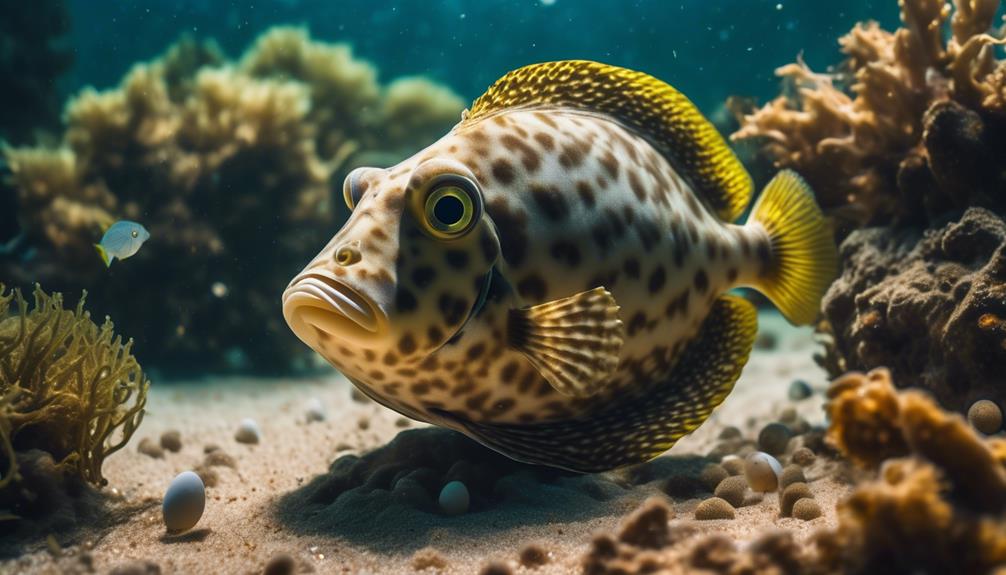
Now let's explore the fascinating world of the breeding behavior of flounder fish, shedding light on their reproductive processes and strategies.
Flounder fish reach sexual maturity at around 3 years old. As they age, the size of each spawn grows, with older flounder producing as many as 4,000,000 eggs or more. Young females can produce an impressive number of up to 500,000 eggs in a single season.
These eggs are released into the water column and float freely until hatching. Flounder fish employ a large reproductive output strategy, producing a high number of eggs to increase the chances of survival for their offspring.
Sexual Maturity and Egg Production in Flounder Fish
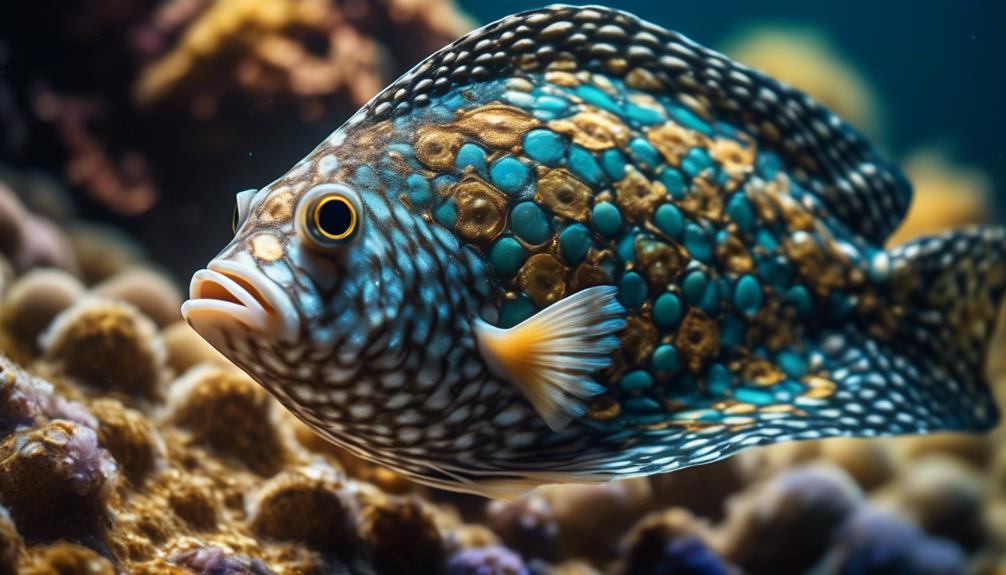
Flounder fish reach sexual maturity at around 3 years old. As they age, the size of each spawn grows, with older flounder producing as many as 4,000,000 eggs or more. The eggs are released into the water column and float freely until hatching.
The sexual maturity and egg production in flounder fish can be summarized as follows:
- Flounder fish reach sexual maturity at around 3 years old.
- The size of each spawn increases with age.
- Older flounder can produce as many as 4,000,000 eggs or more.
It is fascinating to observe how flounder fish develop and increase their egg production as they grow older. This reproductive behavior is a remarkable aspect of their life cycle, showcasing their ability to adapt and ensure the survival of their species.
Maintaining a Flounder Fish Aquarium
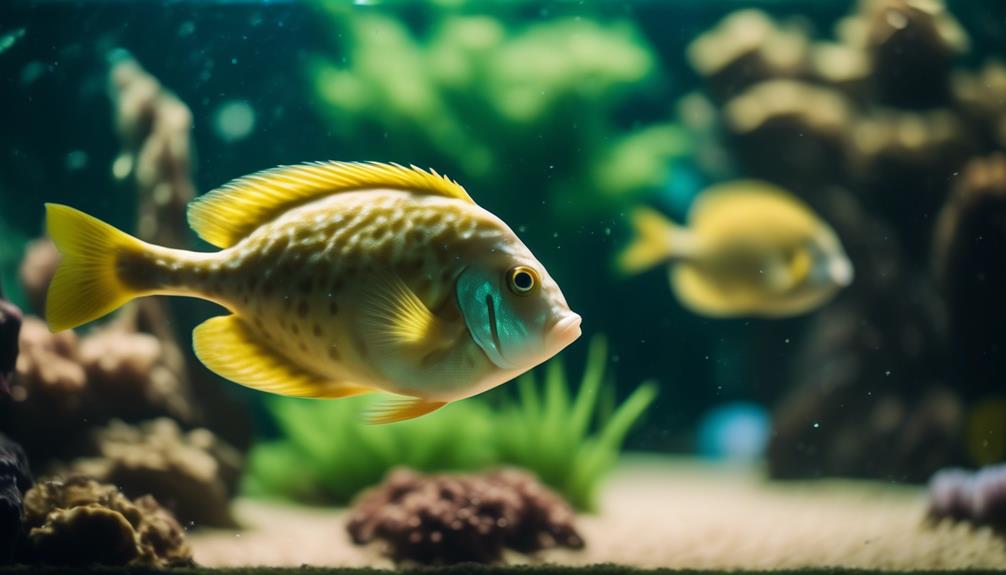
As you maintain a flounder fish aquarium, it's crucial to ensure the proper conditions and care for these fascinating creatures.
Flounders require very large tanks, at least 125 gallons in capacity, as they inhabit the lower level of the tank and burrow into the sandy substrate. The aquarium should have a sand or fine gravel substrate and be sparsely decorated with live rock or hardy corals.
It's important to maintain water conditions with a slightly alkaline pH range between 8.1 and 8.4 and moderate hardness between 8 and 12 dKH.
When it comes to feeding, flounders are carnivorous and primarily feed on small fish and crustaceans. Offer a variety of fresh and frozen meaty foods such as worms, shrimp, and small fish.
Flounder Fish Care and Maintenance
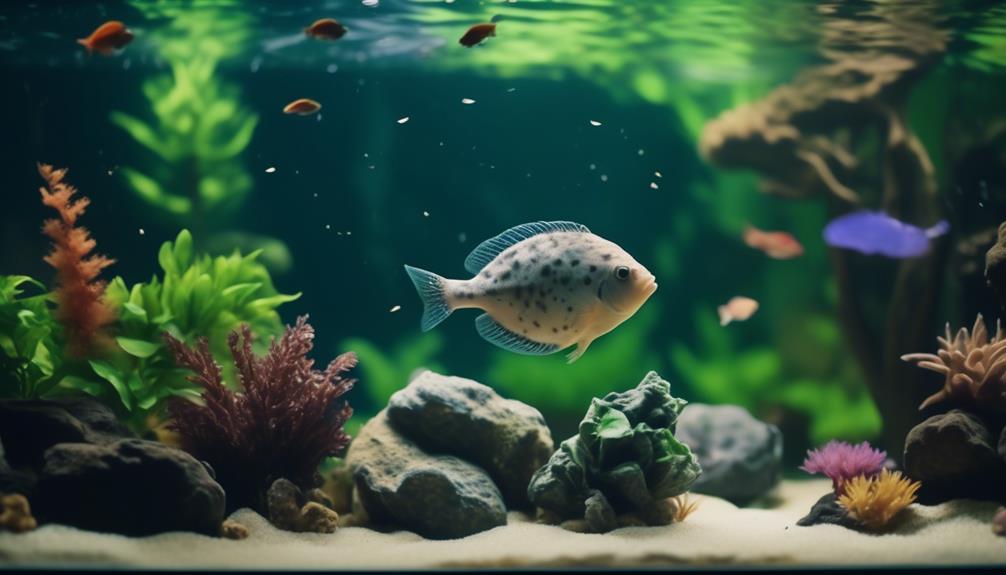
To properly care for and maintain your flounder fish, it's essential to create the right environment and provide the necessary conditions for their well-being. Here are a few key points to keep in mind:
- Tank Requirements:
- Provide a very large tank, at least 125 gallons in capacity, as flounders need ample space.
- Use sand or fine gravel substrate in the aquarium for them to burrow into.
- Decorate the tank sparsely with live rock or hardy corals to mimic their natural habitat.
- Water Conditions:
- Maintain a slightly alkaline pH range between 8.1 and 8.4.
- Keep the water hardness at a moderate level between 8 and 12 dKH.
- Feeding:
- Flounders are carnivorous and primarily feed on small fish and crustaceans.
- Offer a variety of fresh and frozen meaty foods in the home aquarium, such as worms, shrimp, and small fish.
Choosing the Right Substrate for Flounder Fish
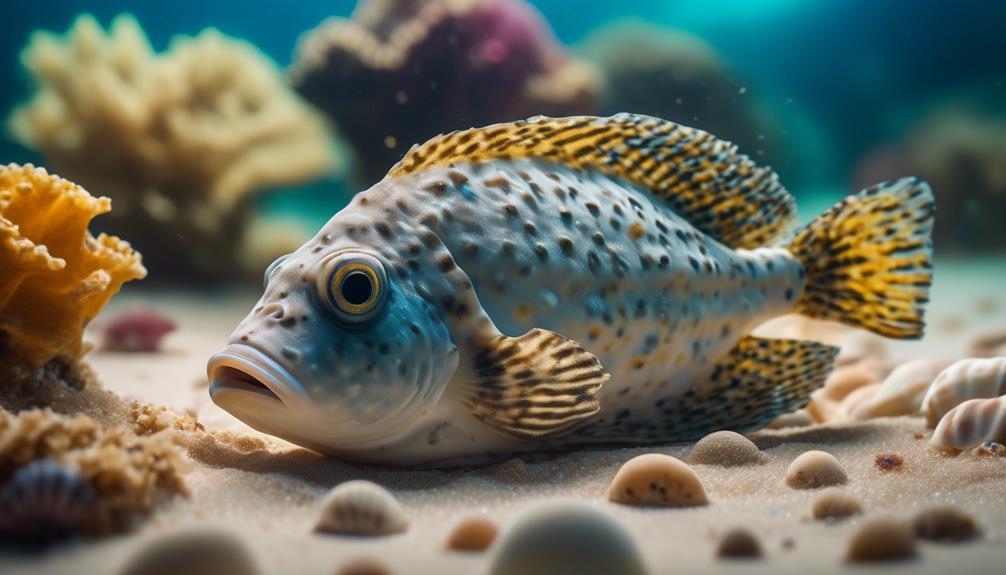
When setting up your aquarium for flounder fish, selecting the appropriate substrate is crucial for creating a suitable environment that mimics their natural habitat. Flounders are designed to blend into their surroundings in the sandy substrate, so it is important to choose a substrate that allows them to camouflage themselves effectively. Sand or fine gravel is the ideal choice for their tank, as it allows them to burrow and hide. Avoid using coarse gravel or sharp rocks, as these can potentially injure the delicate skin of the flounder. Additionally, it is recommended to keep the tank sparsely decorated with live rock or hardy corals to provide hiding places for the flounder. By creating a comfortable and natural environment with the right substrate, you can ensure the well-being and happiness of your flounder fish.
| Pros | Cons | Recommendations |
|---|---|---|
| Mimics natural habitat | Requires regular cleaning | Choose sand or fine gravel substrate |
| Provides hiding places for flounder | Coarse gravel can injure flounder | Avoid using coarse gravel or sharp rocks |
| Allows flounder to camouflage | Excessive decorations can stress fish | Keep the tank sparsely decorated |
Water Conditions for Flounder Fish
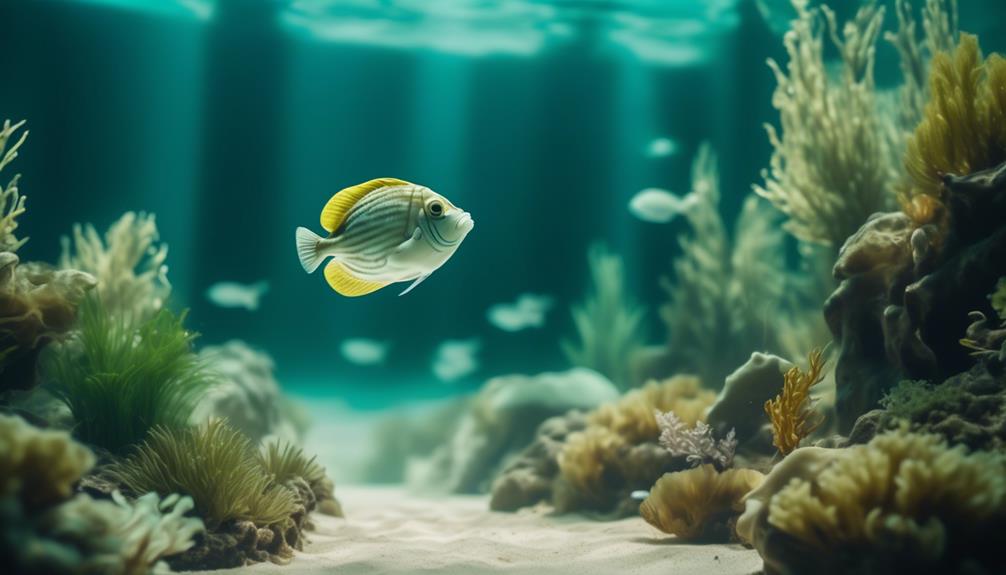
To ensure the health and well-being of your flounder fish, it's essential to maintain appropriate water conditions in their aquarium. Here are three important factors to consider:
- Temperature: Flounder fish thrive in warm water conditions. The ideal temperature range for flounders is between 75 to 82 degrees Fahrenheit.
- pH Level: Flounder fish prefer slightly alkaline water with a pH range between 8.1 and 8.4. It's important to regularly test and adjust the pH level to ensure optimal conditions.
- Water Hardness: Flounder fish require moderate water hardness between 8 and 12 dKH. This can be achieved by using appropriate water conditioners and monitoring the hardness levels regularly.
Flounder Fish Coloration and Camouflage
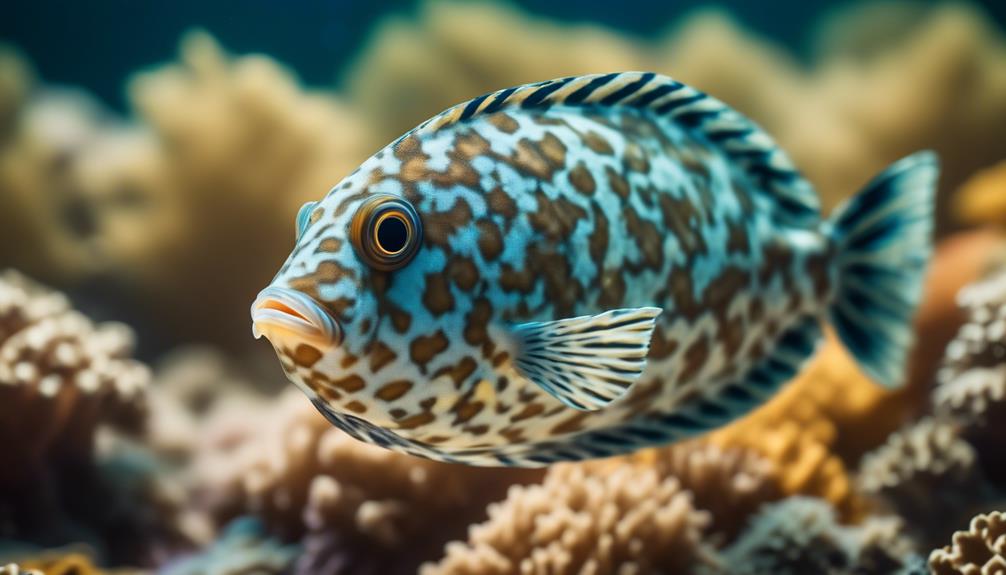
Flounder fish exhibit remarkable coloration and camouflage techniques to blend seamlessly into their sandy substrate surroundings. Most flounders are not colorful fish, but rather designed to blend into their surroundings in the sandy substrate. They typically exhibit combinations of brown, cream, gray, black, or white, allowing them to effectively camouflage themselves. The table below provides a summary of the flounder fish coloration and camouflage techniques:
| Coloration | Camouflage Technique |
|---|---|
| Brown | Mimicking the sandy bottom |
| Cream | Blending with the sandy substrate |
| Gray | Matching the color of rocks or shells |
| Black | Hiding in shadowy areas |
| White | Masquerading as a floating object |
These coloration and camouflage techniques enable flounder fish to stay hidden from predators and ambush their prey. By blending into their environment, flounders have a higher chance of survival in the wild.
Tips for Keeping Flounder Fish Happy and Healthy
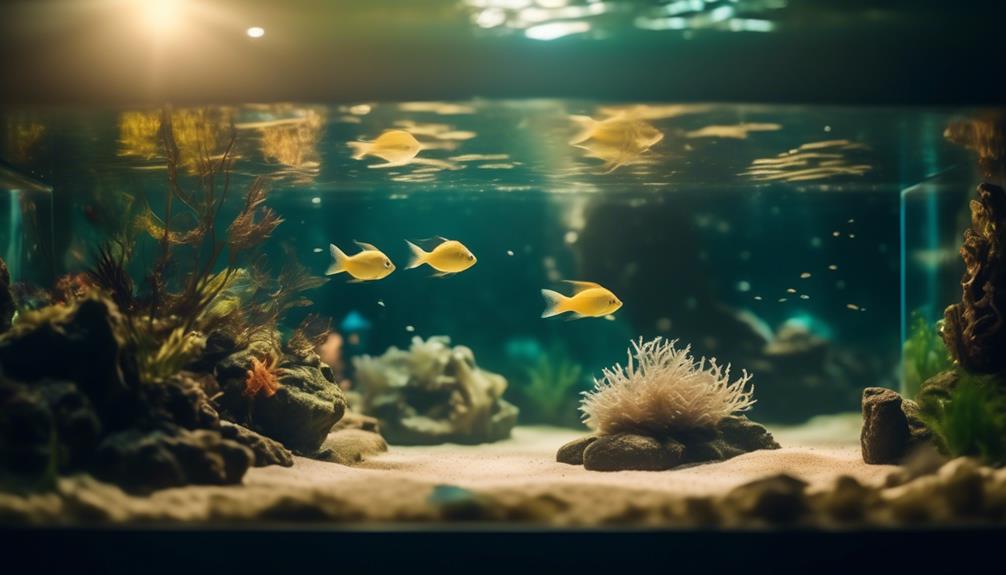
To ensure the happiness and health of your flounder fish, it's important to follow these key tips:
- Provide a very large aquarium: Flounder fish require spacious tanks with a capacity of at least 125 gallons. This allows them to have plenty of space to swim and burrow into the sandy substrate.
- Maintain suitable tank mates: Choose non-aggressive upper region fish that aren't small enough to be seen as prey. Flounder fish are semi-aggressive, so it's important to select compatible tank mates to prevent any conflicts.
- Keep optimal water conditions: Flounder fish thrive in warm water with a slightly alkaline pH level between 8.1 and 8.4. The water should also have moderate hardness between 8 and 12 dKH. Regularly monitor and maintain these conditions to ensure the well-being of your flounder fish.
Frequently Asked Questions
Can Flounder Fish Change Their Coloration to Match Their Surroundings?
Yes, flounder fish can change their coloration to match their surroundings. They have the ability to blend into their environment by exhibiting combinations of brown, cream, gray, black, or white.
How Long Does It Take for Flounder Fish Eggs to Hatch?
Flounder fish eggs can take some time to hatch. The exact duration depends on the flounder's age and size. Young females can produce up to 500,000 eggs in a season, while older ones may produce over 4,000,000 eggs.
Can Flounder Fish Be Kept in a Community Tank With Other Aggressive Fish?
Flounder fish should not be kept in a community tank with other aggressive fish. They are semi-aggressive themselves and require a large tank with non-aggressive upper region fish as suitable tank mates.
What Is the Average Lifespan of a Flounder Fish?
The average lifespan of a flounder fish is around 10 to 15 years. They require a large tank and specific water conditions, so make sure to provide them with the proper care for a long and happy life.
Are There Any Specific Water Parameters That Are Crucial for Maintaining a Healthy Flounder Fish Aquarium?
To maintain a healthy flounder fish aquarium, you need a very large tank with sand or fine gravel substrate. Keep the water slightly alkaline with a pH range of 8.1 to 8.4 and moderate hardness between 8 and 12 dKH.
What Are the Similarities and Differences Between Flounder Fish and Swordtail Fish?
Flounder fish and swordtail fish share a similar hardy and peaceful nature, making them suitable for community aquariums. However, they differ in appearance and behavior. Flounders are flat and camouflaged bottom-dwellers, while swordtail fish have a more colorful and active swimming behavior. Both make fantastic additions to any aquarium.
Conclusion
In conclusion, diving into the captivating world of flounder fish is a mesmerizing journey. From their unique characteristics and habitat to their tank requirements and suitable tank mates, we've explored all the essential information to ensure the well-being of these fascinating creatures.
By providing the right substrate and maintaining the ideal water conditions, you can keep your flounder fish happy and healthy.
So, embark on this adventure and unlock the mysteries of the mesmerizing flounder fish!




